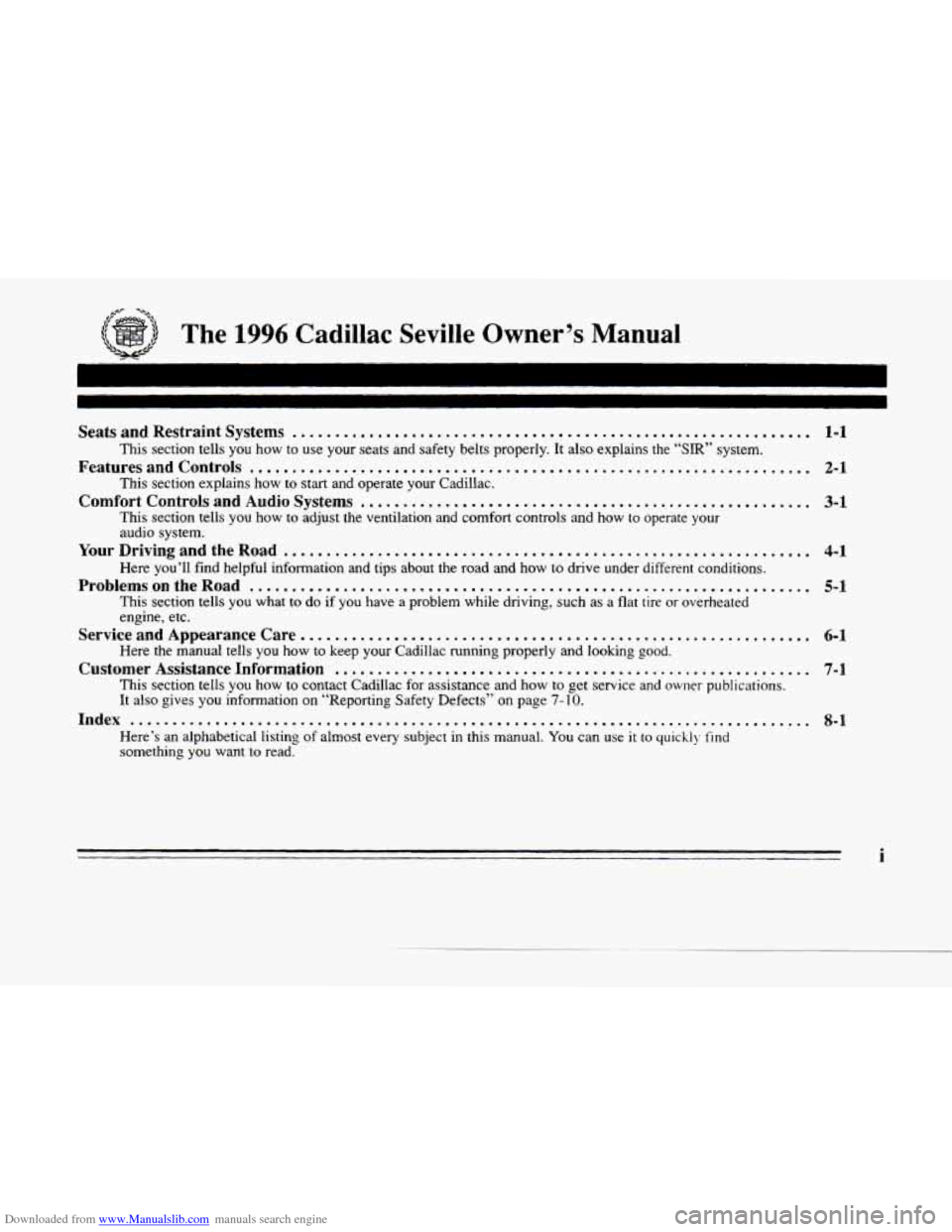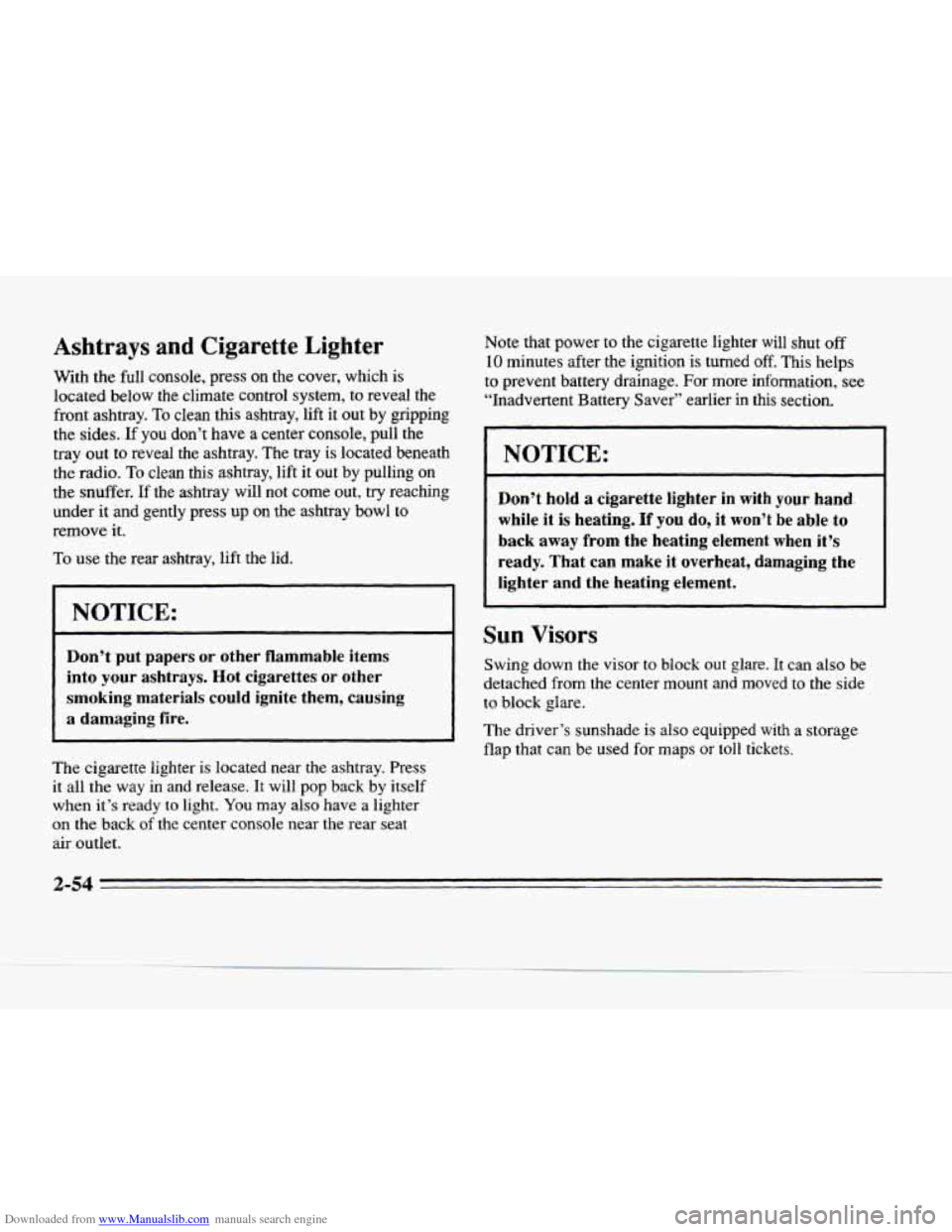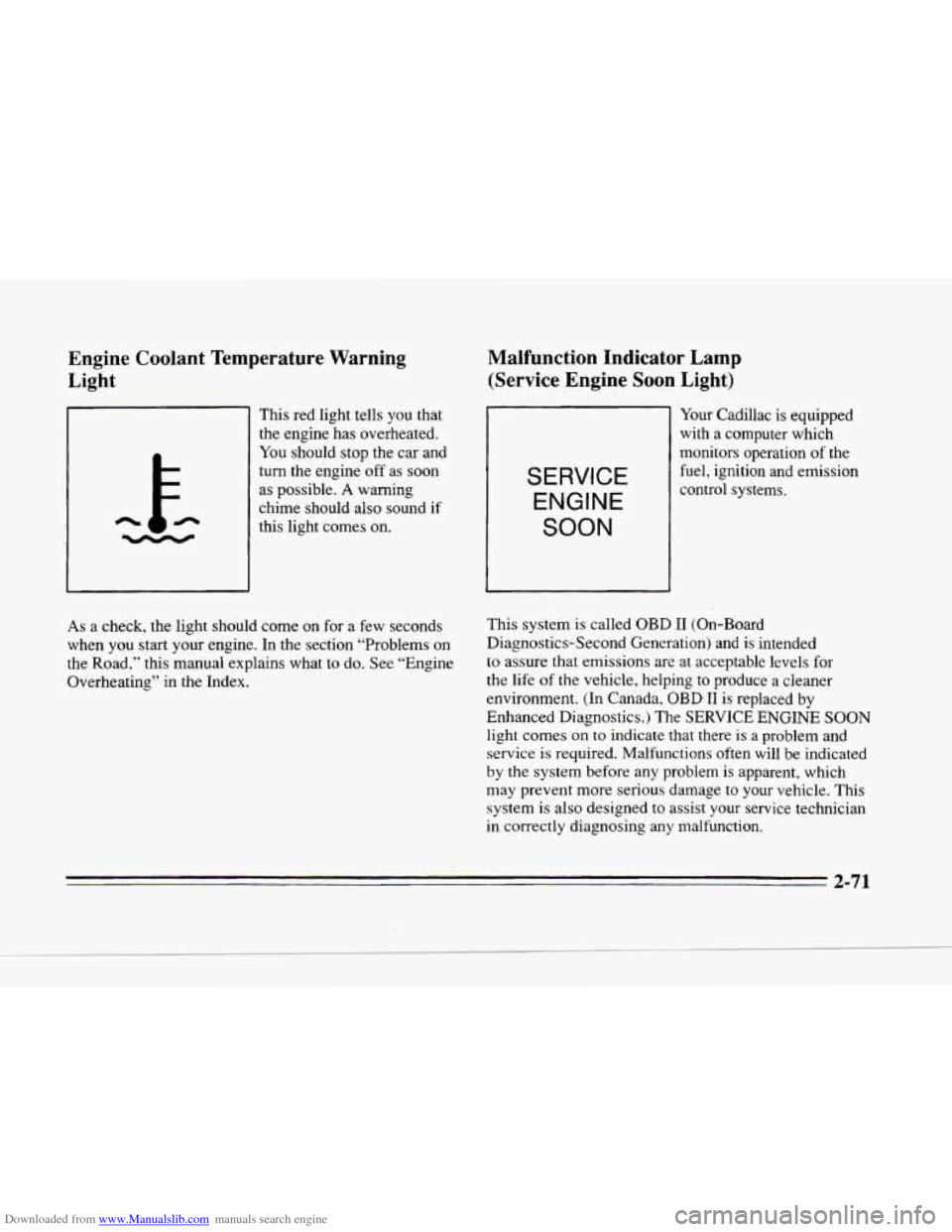1996 CADILLAC SEVILLE engine overheat
[x] Cancel search: engine overheatPage 2 of 354

Downloaded from www.Manualslib.com manuals search engine ,-+- -As,
The 1996 Cadillac Seville Owner’s Manual
Ip
Seats and Restraint Systems .............................................................
This section tells you how to use your seats and safety belts properly. It also explains the “SIR” system.
FeaturesandControls ..................................................................
This section explains how to start and operate your Cadillac.
This section tells you how to adjust the ventilation and comfort controls and how to oper\
ate
your
audio system.
YourDrivingandtheRoad ..............................................................
Here you’ll find helpful information and tips about the road and how to drive under different conditions.
ProblemsontheRoad ..................................................................
This section tells you what to do if you have a problem while driving, such as a flat tire or overheated
engine, etc.
Here the manual tells
you how to keep your Cadillac running properly and looking good.
This section tells you how to contact Cadillac for assistance and how to get service and owner publications.
It also gives you information on “Reporting Safety Defects” on page 7-10.
Here’s
an alphabetical listing of almost everv subject in this manual. You can use it to quickl}. find
something you want to read.
Comfort Controls and Audio Systems .....................................................
ServiceandAppearanceCare ............................................................
Customer Assistance Information ........................................................
Index ........................................................................\
........
1-1
2-1
3-1
4-1
5-1
6-1
7-1
8- 1
i
Page 78 of 354

Downloaded from www.Manualslib.com manuals search engine Engine Coolant Heater (Option) (Canada
Only)
In very cold weather, 0°F (- I 8 O C) or colder, the engine
coolant heater can help.
You’ll get easier starting and
better fuel economy during engine
warm-up. Usually,
the coolant heater should be plugged in a minimum
of
four hours prior to starting your vehicle.
To use the coolant heater:
1. Turn off the engine.
2. Open the hood and unwrap the electrical cord.
3. Plug it into a normal, grounded 110-volt AC outlet.
I A CAUTION:
Plugging the cord into an ungrounded outlet
could cause an electrical shock.
Also, the wrong
kind
of extension cord could overheat and cause
a fire.
You could be seriously injured. Plug the
cord into
a properly grounded three-prong
110-volt
AC outlet. If the cord won’t reach, use a
heavy-duty three-prong extension cord rated for
at least
15 amps.
2-19
Page 82 of 354

Downloaded from www.Manualslib.com manuals search engine r..
L
THIRD (3): This position is also used for normal
driving however, it offers more power and lower fuel
economy than OVERDRIVE
(@).
Here are examples for using THIRD (3) instead of
OVERDRIVE (a):
0 When driving on hilly, winding roads.
When towing a trailer, so there is less shifting
between gears.
0 When going down a steep hill.
SECOND (2): This position gives you more power. You
can use SECOND
(2) on hills. It can help control your
speed as
you go down steep mountain roads, but then
you would also want to use your brakes
off and on.
I NOTICE:
r
~~
Don’t shift into SECOND (2) unless you are going
slower than
65 mph (105 km/h), or you can
damage your engine. FIRST
(1): This
position gives you even more power
than SECOND
(2). You can use it on very steep hills,
or in deep snow or mud. (If the shift lever is put in
FIRST (l), the transaxle won’t shift into first gear
until the vehicle is going slowly enough.)
NOTICE:
If your front wheels can’t rotate, don’t try to
drive. This might happen if you were stuck in
very deep sand or mud or were
up against a solid
object.
You could damage your transaxle.
Also, if you stop when going uphill, don’t hold
your vehicle there with only the accelerator
pedal. This could cause overheating and damage
the transaxle.
Use your brakes to hold your
vehicle in position on
a hill.
2-23
Page 84 of 354

Downloaded from www.Manualslib.com manuals search engine i
I A CAUTION:
If your hand or arm is in the way of the pedal,
you could be hurt. The pedal springs back
quickly. Keep your hand and arm away when
you use the manual release lever.
I
NOTICE:
Driving with the parking brake on can cause
your rear brakes to overheat.
You may have to
replace them and you could also damage other
parts of your vehicle.
Shifting Into PARK (P)
1 A CAUTION:
If you are towing a trailer and are parking on a hill, see
“Towing a Trailer” in the Index. This section shows
what to do first to keep the trailer from moving. It
can be dangerous to’get out
of your vehicle if
the shift lever is not fully in
PARK (P) with the
parking brake firmly set. Your vehicle can roll.
If you have left the engine running, the vehicle
can move suddenly.
You or others could be
injured. To be sure your vehicle won’t move, even
when you’re on fairly level ground, use the steps
that follow.
If you’re pulling a trailer, see
“Towing
a Trailer” in the Index.
2-25
Page 86 of 354

Downloaded from www.Manualslib.com manuals search engine -
--
2. Move the sh.& lever into the PARK (P) position like ths:
. , .. .,#, .. rc; I/,< .. ~ . .. . , . .,. . .. , , ,,, ..I ...-gg . .!.
3. Hold in the button ~fl the leifef ha push the lever all
the way toward the front of your vehicle.
4. With your right foot still holding the brake pedal
down, set the parking brake.
5. Move the ignition key to LOCK.
6. Remove the key and take it with you. If you can
leave your vehicle with the ignition key in your
hand, your vehicle is in
PARK (P).
Leaving Your Vehicle With the Engine
Running
1 A CAUTION:
It can be dangerous to leave your vehicle with
the engine running. Your vehicle could move
suddenly
if the shift lever is not fully in PARK (P)
with the parking brake firmly set. And, if you
leave the vehicle with the engine running, it could
overheat and even catch fire.
You or others could
be injured. Don’t leave your vehicle with the
engine running unless you have to.
If you have to leave your vehicle with the engine
running, be sure your vehicle is in PARK
(P) and your
parking brake
is firmly set before you leave it. After
you’ve moved the shift lever into the PARK
(P)
position. hold the regular brake pedal down. Then, see
if you can move the shift lever away from PARK (P)
without first pulling it toward you (or, if you have the
console shift lever, without first pressing the button).
If
you can. it means that the shift lever wasn’t fully locked
into
PARK (a).
2-27
Page 113 of 354

Downloaded from www.Manualslib.com manuals search engine Ashtrays and Cigarette Lighter
With the full console, press on the cover, which is
located below the climate control system, to reveal the
front ashtray.
To clean this ashtray, lift it out by gripping
the
sides. If you don’t have a center console, pull the
tray out to reveal the ashtray. The tray
is located beneath
the radio.
To clean this ashtray, lift it out by pulling on
the snuffer. If the ashtray will not come out, try reaching
under it and gently press up
on the ashtray bowl to
remove it.
To use the rear ashtray, lift the lid.
I NOTICE:
Don’t put papers or other flammable items
into your ashtrays. Hot cigarettes or other
smoking materials could ignite them, causing
a damaging fire.
The cigarette lighter is located near the ashtray. Press
it all the way in and release.
It will pop back by itself
when
it’s ready to light. You may also have a lighter
on the back
of the center console near the rear seat
air outlet. Note
that power
to the cigarette lighter will shut off
10 minutes after the ignition is turned off. This helps
to prevent battery drainage. For more information,
see
“Inadvertent Battery Saver” earlier in this section.
I NOTICE:
Don’t hold a cigarette 1,ighter in with your hand.
while it is heating.
If you do, it won’t be able to
back away from the heating element when it’s
ready. That can make it overheat, damaging the
lighter
and the heating element.
Sun Visors
Swing down the visor to block out glare. It can also be
detached from the center mount and moved
to the side
to block glare.
The driver’s sunshade is
also equipped with a storage
flap that can be used for maps or toll tickets.
Page 130 of 354

Downloaded from www.Manualslib.com manuals search engine Engine Coolant Temperature Warning
Light
This red light tells you that
the engine has overheated.
You should stop the car and
turn the engine off as soon
as possible.
A warning
chime should also sound if
this light comes on.
As a check, the light should come on for a few seconds
when you start your engine. In the section “Problems on
the Road,” this manual explains what to do. See “Engine
Overheating’’ in the Index.
Malfunction Indicator Lamp
(Service Engine
Soon Light)
SERVICE
ENGINE
SOON
Your Cadillac is equipped
with a computer which
monitors operation of the
fuel, ignition and emission
control systems.
This system is called OBD
I1 (.On-Board
Diagnostics-Second Generation) and is intended
to assure that emissions are at acceptable levels for
the life
of the vehicle, helping to produce a cleaner
environment. (In Canada,
OBD I1 is replaced by
Enhanced Diagnostics.) The SERVICE ENGINE SOON
light comes on to indicate that there is a problem and
service is required. Malfunctions often will be indicated
by the system before any problem is apparent, which
may prevent more serious damage to your vehicle. This
system is also designed
to assist your service technician
in correctly diagnosing any malfunction.
2-71
Page 141 of 354

Downloaded from www.Manualslib.com manuals search engine CHECK COOLANT LEVEL - 02: This message will
appear when there is a low level of engine coolant. Have
the cooling system serviced by a Cadillac technician
as
soon as possible.
CHECK FUEL GAGE - 39: This message will appear
when the fuel supply is less than four gallons
(15.2 L)
and the display is turned off (digital clusters only).
CHECK OIL LEVEL - 36: For correct operation of
the low oil sensing system, your vehicle should be on a
level surface.
A false CHECK OIL LEVEL message
may appear if the vehicle
is parked on grades. The oil
level sensing system does not check for actual oil level
if the engine has been off for
a short period of time, and
the oil level is never sensed while the engine is running.
If the CHECK OIL LEVEL message appears, and your
vehicle has been parked on level ground with the engine
off
for at least 30 minutes, the oil level should be
checked by observing the
oil dipstick. Prior to checking
the oil level be sure the engine has been off for five
minutes and your vehicle
is on a level surface. Then
check the dipstick and add oil if necessary. See “Engine
Oil” in the Index.
CHECK WASHER FLUID - 25: This message will
appear
for several seconds indicating that you need
washer solvent.
CRUISE ENGAGED - 43: This message will
appear for
a few seconds when you select a speed at
which to cruise.
DOOR OPEN - 141: The passenger‘s door is open or
ajar when this message appears. The vehicle’s engine
must be running and the transaxle not
in PARK (I?) for
this message to display. A chime will also sound when
the vehicle’s speed is greater than
5 mph (8.1 km/h).
DRIVER DOOR OPEN - 140: This message
will display when the vehicle is being shifted out of
PARK (P) with the engine running to signal that the
driver’s door
is open or ajar. A chime will also sound
when the vehicle’s speed
is greater than 5 mph
(8.1 km/h).
ENGINE COOLANT HOT-IDLE ENGINE - 44:
This message will appear when the engine coolant
temperature is over
248 “F ( 1 24°C). To avoid added
strain on a hot engine, turn
off the climate control
system. Stop and allow your vehicle
to idle until it cools
down
or the message is removed. If it does not cool
down, turn off the engine and
have it serviced before
driving it again. Severe engine damage can result from
an overheated engine. See
“Engine Overheating” in
the Index.
2-82